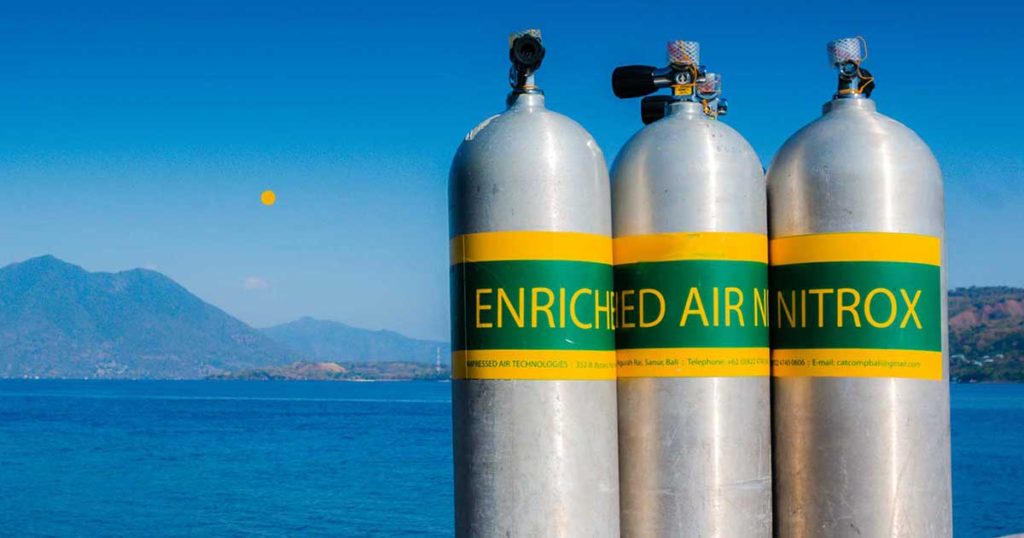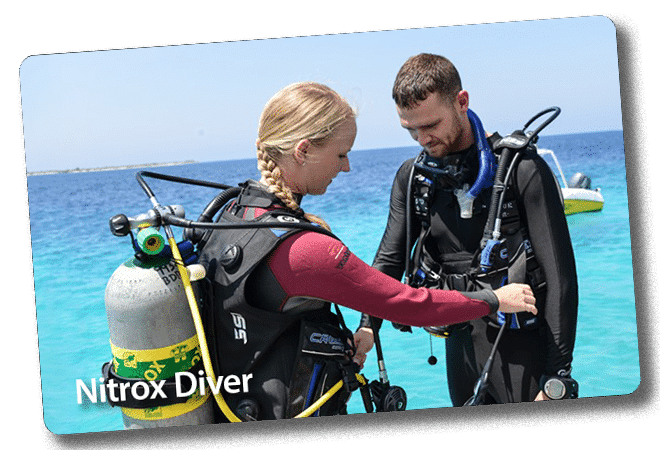Longer bottom times. Shorter surface intervals. And, possibly, greater safety margins. This explains why so many divers choose to take a Nitrox Diver class either in conjunction with or soon after their Open Water Diver course. In this article, we answer three questions. These are:
- What is Nitrox?
- Why dive Nitrox?
- How do you become a Nitrox Diver?
What is Nitrox?
Nitrox is any gas mixture consisting primarily of oxygen and nitrogen. So, strictly speaking, air is a form of Nitrox (although you are unlikely to hear anyone refer to it as such).
When divers refer to Nitrox, they are generally referring to Enriched Air Nitrox. This is a mixture in which the oxygen concentration is greater than the 21 percent found in air. And, if the oxygen concentration is greater, the nitrogen concentration is less than that found in air. For example:
- The most common Nitrox mixture is NOAA Nitrox I, also known as EAN32. It contains roughly 32 percent oxygen and 68 percent nitrogen.
- Another common Nitrox mixture is NOAA Nitrox II, also known as EAN36. It contains roughly 36 percent oxygen and 64 percent nitrogen.
- You are not limited to just these two mixtures. It’s possible to create Nitrox mixtures in which the oxygen concentration is optimized for the planned maximum depth.
Ironically, the term Enriched Air is incredibly misleading. Adding oxygen to air provides no additional benefit other than being a cost-effective way to dilute the nitrogen in a gas mixture. In fact, in sufficient concentrates, the additional oxygen can actually kill you.
An important part of Nitrox Diver training teaches students how to ensure their exposure to elevated partial pressures of oxygen stays within safe limits. Part of the popularity of EAN32 is the fact you can take it as deep as the recommended sport diving limit of 100 feet and still remain within its Maximum Operating Depth or MOD and not incur substantial risk.
Why dive Nitrox?
The real benefit of diving Nitrox has nothing to do with the increased concentration of oxygen and everything to do with the decreased concentration of nitrogen. For example:
- An EAN32 dive to 98 feet exposes you to no more nitrogen than you would encounter on an air dive to 80 feet.
- This means your no-decompression limit for such a dive will be based on the no-decompression limit for 80-foot air dives.
- On most dive tables and computers, the no-deco limit for a 98-foot air dive is around 20 minutes. On EAN32, the same dive typically has a no-deco limit of 30 minutes.
This then is the primary benefit of diving Nitrox: Longer bottom times. But, in the words of the immortal product pitchman Billy Mays, “Wait…there’s more!”
- Because you surface from most Nitrox dives with less dissolved nitrogen in your system than you would acquire on a comparable air dive, the time you must wait on the surface between dives is generally less.
- Therefore, Nitrox can not only provide longer bottom times but shorter surface intervals as well. Especially if you make subsequent dives on Nitrox.
Past a certain depth, the limiting factor for most single-tank divers is not the no-decompression limit but rather how much breathing gas they can take with them.
So, at 100 feet, you may not be able to stay down any longer on Nitrox than you can on air. But, when you surface from such a dive, you will have substantially less dissolved nitrogen in you system than you would if diving air.. This leads to the third possible benefit of diving Nitrox: Greater safety margins.
How do you become a Nitrox Diver?
Let’s state the obvious here: You become a Nitrox Diver by taking a Nitrox Diver course. You can take this in conjunction with your Open Water Diver course or at any time following certification.
What distinguishes the Nitrox Diver course from other Specialty Diver classes is that there are no required dives and no underwater skills to master. Most of the course revolves around mastering important background knowledge through eLearning.
The only real hands-on “skills” in the Nitrox Diver course is learning how to use an oxygen analyzer and properly labeling Nitrox cylinders for oxygen content and Maximum Operating Depth (MOD). We do this in the shop with students once they complete their eLearning.
We can pretty much conduct Nitrox Diver training when it’s most convenient for you. You can learn more on our website or by calling or visiting the store. — ©2021 • Sinulogic LLC



